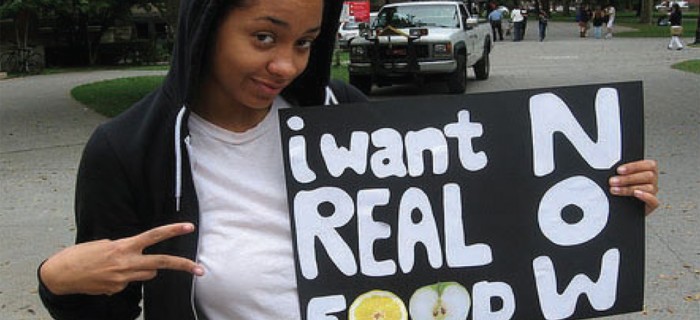Youth and Food Justice: Lessons from the Civil Rights movement
Food First Backgrounder, Fall 2010, Vol. 16, No. 3
The food justice movement is entering a new period of opportunity. Good, fresh, healthy food is on the agenda in underserved neighborhoods and even First Lady, Michelle Obama has planted an organic garden and taken on childhood obesity with her Let’s Move! campaign. But fair and affordable fresh food at 4,000 farmers markets and hundreds of CSAs, with double digit annual growth in organic food over the last 20 years, represents under two percent of the trillion dollar food market.
Improving the health of our youth will require a transformation of our food system. This will require strong social movements capable of creating the political will to truly transform how we grow, buy, prepare and eat food.
Poor diet is condemning one in three African-American children to Type II diabetes by the age of 18 and one in four Latino kids to hypertension and heart disease. Indeed, all of our young people are at risk. The Centers for Disease Control now projects that the youngest generation of Americans will be the first to have a shorter lifespan than their parents—thanks to our toxic food system. Improving the health of our youth will require a transformation of our food system.
This will require strong social movements capable of creating the political will to truly transform how we grow, buy, prepare and eat food. Lessons from the civil rights era suggest how today’s food justice movement can organize. In particular, a new, youth-led, multiracial coalition could unleash the voice and energy of those with the most to gain from transforming the food system—young people.
What does Fast Food have in common with Jim Crow?
The political disenfranchisement addressed by the Civil Rights movement, and the cheap, unhealthy food plaguing our underserved communities both reflect structural inequities that marginalize people of color. Poverty—the cause of hunger and poor diet—is built-in through “redlining” by banks and retail outlets and the outmigration of finance, business, jobs and services caused by zoning and suburban development schemes that favor higher earning, primarily white workers, over lower-income people of color. In this sense, the fight for good, fresh, affordable food is a social and economic continuation of the struggle to end discrimination. Turning the “invisible hand” of this skewed marketplace into a helping hand that creates and keeps wealth in underserved communities requires economic and political restructuring for equal opportunities.


 Help Food First to continue growing an informed, transformative, and flourishing food movement.
Help Food First to continue growing an informed, transformative, and flourishing food movement.




